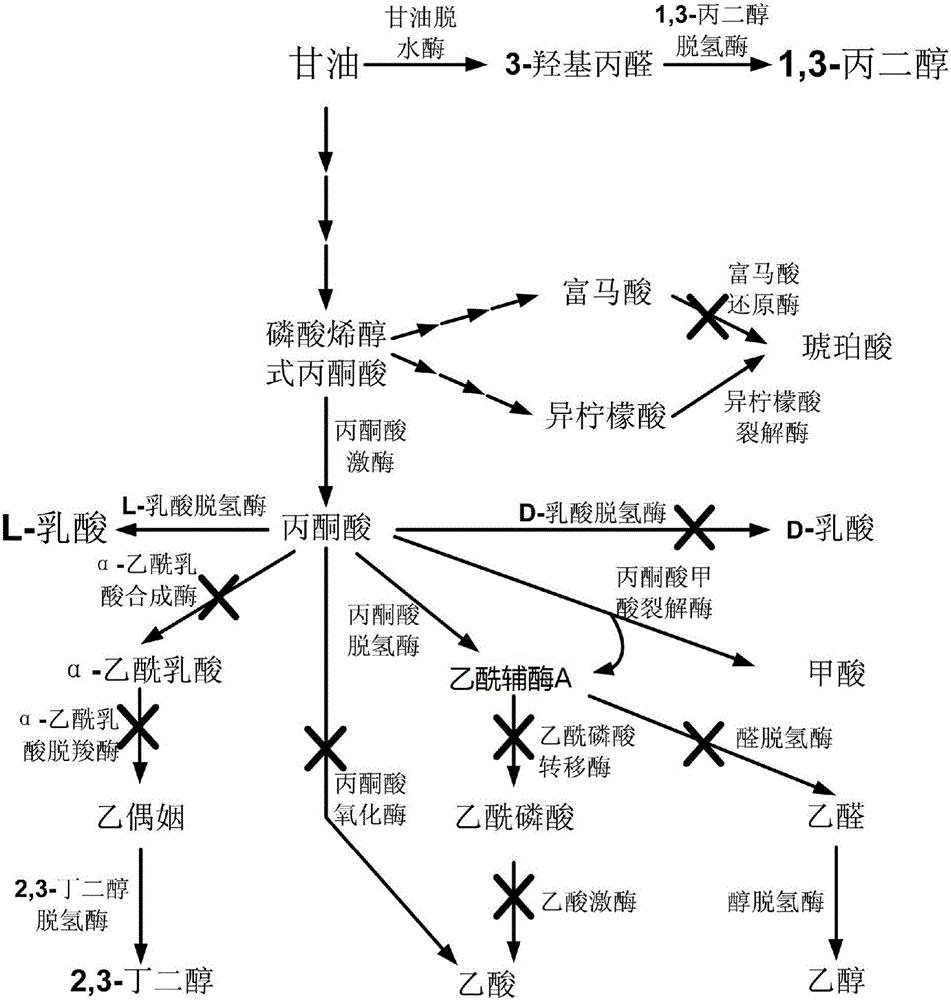Bacterium and constructing method and application thereof
A construction method, a strain technology, applied in the field of bioengineering
- Summary
- Abstract
- Description
- Claims
- Application Information
AI Technical Summary
Problems solved by technology
Method used
Image
Examples
Embodiment 1
[0112] Example 1: Screening and identification of strains with 1,3-PD and LAC as main products
[0113] Weigh 2 g of the soil sample and add it to 50 mL of glycerol liquid medium, and place it in a shaker at 37° C. for 24 hours, and the shaker rotates at 200 rpm. Then the culture solution was diluted with sterile physiological saline, diluted 10-fold, 100-fold, 1000-fold and 10000-fold respectively, and then applied to a petri dish containing glycerol solid medium, and cultured at 37°C for 24 hours. After a single colony grows, select the colony with the largest colony area and the area of the acid-producing transparent zone, inoculate it into a glycerol liquid medium, and place it in a shaker for 24 hours at 37°C with a shaker speed of 200rpm. Centrifuge the culture medium, measure the production of 1,3-PD and LAC in the culture medium, and pick a strain with high production of 1,3-PD and LAC and easy to centrifuge.
[0114] The above strains were separated and purified by...
Embodiment 2
[0118] Example 2: Deficiency of the α-acetolactate decarboxylase gene (budA) and the α-acetolactate synthase gene (budB) in Klebsiella oxytoca PDL-0
[0119] (1) Construction of a vector for partially deleting the budA gene in Klebsiella oxytoca PDL-0
[0120] Primers were designed according to the budA gene sequence (as shown in SEQ ID NO: 1), and the upstream and downstream homologous fragments of the budA gene were amplified by PCR. Using the genomic DNA of Klebsiella oxytoca PDL-0 as a template, primer budA-1: 5'-ACATGATTACGAATTCATGAACCATTCTGCTGAATG-3' (shown in SEQ ID NO: 10) and primer budA-2: 5'-AACGGGCTGGCATCACCGCGAAGGGCGTGC were used -3' (shown in SEQ ID NO:11) was amplified by PCR to obtain an upstream homologous fragment; using primer budA-3: 5'-CGCGGTGATGCCAGCCCGTTTTCCGCTTCA-3' (shown in SEQ ID NO:12) and primer budA -4: 5'-TACCGAGCTCGAATTCTTAGTTTTCGACTGAGCGAA-3' (shown in SEQ ID NO: 13) was amplified by PCR to obtain downstream homologous fragments. The PCR ampl...
Embodiment 3
[0140] Example 3: Deficiency of the aldehyde dehydrogenase gene (adhE) in Klebsiella oxytoca PDL-1
[0141] (1) Construction of a vector for partially deleting the adhE gene in Klebsiella oxytoca PDL-1
[0142] Primers were designed according to the adhE gene sequence (as shown in SEQ ID NO: 3), and the upstream and downstream homologous fragments of the adhE gene were amplified by PCR. Using the genomic DNA of Klebsiella oxytoca PDL-1 as a template, primer adhE-1: 5'-ACATGATTACGAATTCATGGCTGTTACTAATGTCGC-3' (as shown in SEQ ID NO: 18) and primer adhE-2: 5'-TGCTGTCTGTTGGCGTTACGGGTCTTCAGG were used -3' (shown in SEQ ID NO:19) was amplified by PCR to obtain an upstream homologous fragment; using primer adhE-3: 5'-CGTAACGCCAACAGACAGCATTCAGCCAGT-3' (shown in SEQ ID NO:20) and primer adhE -4: 5'-TACCGAGCTCGAATTCTTAAGCGGATTTTTTCGCTT-3' (shown in SEQ ID NO: 21) was amplified by PCR to obtain downstream homologous fragments. The PCR amplification conditions were: 95°C for 5 minutes; ...
PUM
 Login to View More
Login to View More Abstract
Description
Claims
Application Information
 Login to View More
Login to View More - R&D
- Intellectual Property
- Life Sciences
- Materials
- Tech Scout
- Unparalleled Data Quality
- Higher Quality Content
- 60% Fewer Hallucinations
Browse by: Latest US Patents, China's latest patents, Technical Efficacy Thesaurus, Application Domain, Technology Topic, Popular Technical Reports.
© 2025 PatSnap. All rights reserved.Legal|Privacy policy|Modern Slavery Act Transparency Statement|Sitemap|About US| Contact US: help@patsnap.com



